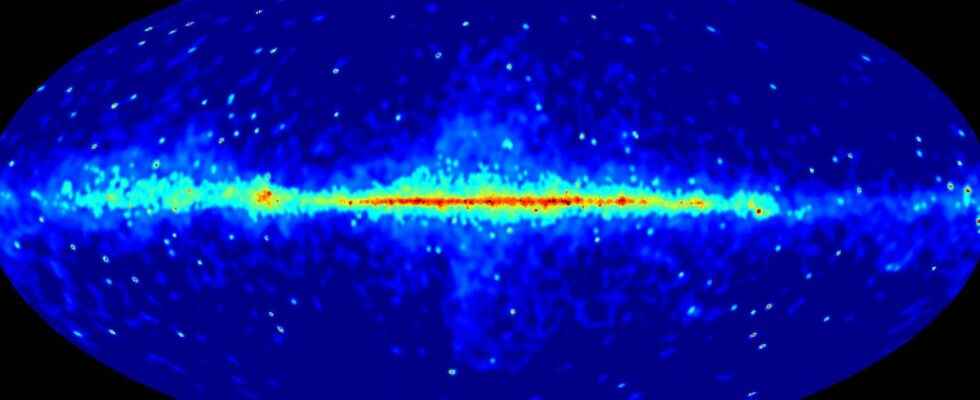You will also be interested
[EN VIDÉO] Discover the first image of the supermassive black hole at the center of its Galaxy! A big step for our knowledge of these mysterious objects… We’ve been waiting for it since 2019, at the same time as the first image of the M87* black hole. It’s finally here: the very first photo of Sagittarius A*, the supermassive black hole at the heart of the Milky Way! © Futura
On either side of the Milky Way are two gigantic bubbles of X, gamma and radio, which form a kind of “8” centered at the level of the galactic disc, or more exactly of the galactic center. Discovered by chance when researchers were tracking the black matter in 2010 using the space telescope Fermi Gamma-Ray, these well-defined bubbles extend over nearly 25,000 light years on each side of the disc. Moreover, they continue to expand at a rate of 1,000 km/s. According to the researchers, they would be three million years old, with a energy of gamma rays ranging between 1 and 100 GeV.
Their origin remains mysterious
But where do they come from? By what were they created? Given the particular symmetrical shape of the Fermi bubbles, they could come from the galactic center, more precisely from the central black hole, Sagittarius A*. This one would spit out high-energy matter from its accretion disk. But a substructure that lies in the brightest region has intrigued an international team of researchers, and is the subject of a publication in Nature Astronomy.
This substructure, called, according to the study, ” the cocoon », is closest to the galactic center and contains gas hot to over 8 million degrees Celsius so that, until today, it was interpreted as coming from the same source as the rest of the Fermi bubbles.
Indeed, the central black hole Sagittarius A* may have accreted a large amount of matter several million years ago, resulting in the ejection of gas and dust under high temperature and high velocity. This hypothesis, which however did not achieve consensus, has just been contradicted by the new study!
According to the researchers, the base of the bubbles “is probably due to the galaxy Sagittarius dwarf spheroidal ». It is about 50,000 light-years from the center of the Milky Way and orbit around our Galaxy, being little by little torn off stars. Although it no longer produces stars, it would house, according to the study, a real “population of pulsar milliseconds”that is to say ofneutron stars rotating at breakneck speeds.
The Sagittarius galaxy hides behind the galactic disc
But above all, “This large satellite of the Milky Way is seen through the Fermi bubbles from the position of the Solar system », hence the hypothesis of the researchers according to which, it is in fact only she that we see at the base of the bubbles of Closed ! Or rather, the millisecond pulsars it would contain. To make sure, they modeled several possible scenarios, including that of theemission from black hole central, and that of the dwarf galaxy. It is the latter case that best corresponded to the measurements observed.
The gamma-ray sky hosts a pair of gigantic galactic bubbles. The Fermi Bubbles were discovered in 2010, and scientists still aren’t sure what made them, when they formed, or why they appear so smooth. They remain a fascinating mystery! https://t.co/SpGzNMkqbJ#NoRhymeOrReasonDaypic.twitter.com/1dSNB6bPeE
—NASA Universe (@NASAUniverse) September 1, 2022
As for the millisecond pulsars within the Sagittarius galaxy, the researchers identified them as being responsible by elimination. No collision within the interstellar medium, as gas from the galaxy was sucked in by the Milky Way. No supernovas either, because the latter release gas, and the Fermi bubbles do not contain any. All that remained were the millisecond pulsars, the remnants of dead massive stars that emit powerful radiation from their poles.
A result that could complicate the search for black matterbecause it is detected in particular by gamma radiation emitted when particles of dark matter and the antiparticles mutually annihilate each other. Finally, for researchers, “This finding plausibly suggests that millisecond pulsars produce significant γ-ray emission among ancient stellar populations, which could confound indirect searches for dark matter in regions such as the galactic center, the andromeda galaxy and other dwarf galaxies in the Milky Way. »
Interested in what you just read?
